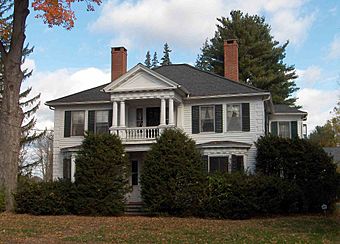Granby Center Historic District facts for kids
Quick facts for kids |
|
|
Granby Center Historic District
|
|
 |
|
| Location | 3–8 E. Granby Rd., 2 Park Pl., and 207–265 Salmon Brook St. S, Granby, Connecticut |
|---|---|
| Area | 85 acres (34 ha) |
| Architectural style | Colonial Revival, Queen Anne, Federal |
| NRHP reference No. | 85003149 |
| Added to NRHP | October 17, 1985 |
The Granby Center Historic District is a special area in Granby, Connecticut. It's mostly a neighborhood with old houses. This area became a village in the 1700s, starting as a farming community. Today, you can see many different building styles from the late 1700s to the early 1900s here. This historic district was added to the National Register of Historic Places (NRHP) in 1985.
Contents
Exploring Granby Center's Past
The town of Granby was first settled in the 1600s. It was once part of Simsbury before becoming its own town in 1786. Granby Center is one of three villages in the town. It has always been the main center for town activities.
How Granby Center Grew
In the past, people built their homes in the village. Their farms were in the areas outside the village. This was common practice back then. The main street for these homes was what we now call South Salmon Brook Street. This street, which is now Connecticut Route 10 and United States Route 202, still has wide lawns and houses spaced far apart. Many of the first town buildings and shops are gone. This is partly because of a big fire in 1876.
Buildings in the District
The historic district starts where Salmon Brook Street, Granby Road, and Hartford Avenue meet. It goes south to a modern fire station. This area has 35 historic buildings. Two of these buildings are from the 1700s. Twenty-four buildings are from the 1800s. Eight buildings were built in the 1900s.
The buildings show many different styles. These include Colonial Revival, Queen Anne, Italianate, Georgian, and Federal styles. Most of the buildings were once homes. For example, the building at 4 East Granby Road was a house. The building at 2 Park Place was first a home, then a hotel, and then a home again. One building used to be a school. It served as the town hall from 1951 to 1964.
Images for kids




